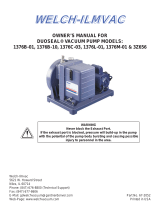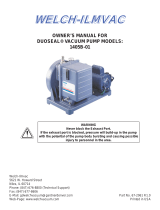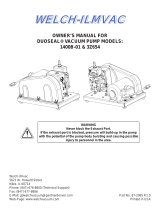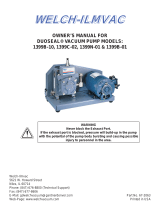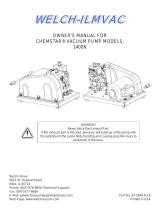Page is loading ...

OWNER’S MANUAL
FOR
DRY VACUUM PUMPS
MODELS:
2014
2032 / 2042
2034 / 2044
2037 / 2047
Part No. 642779
Printed in USA
WARNING
Be sure to properly identify intake and exhaust before using the
pump. See Section 2.15
CAUTION
Do not pump liquids with the pump. Pumping liquids will cause the
pump to stop working.
WELCH-ILMVAC
Welch-Ilmvac
5621 W. Howard Street
Niles, IL 60714
Phone: (847) 676-8800 (Technical Support)
Fax: (847) 677-8606
E-Mail: gdwelchvacuum@gardnerdenver.com
Web-Page: www.welchvacuum.com

INSTRUCTION
WARNING AND CAUTION
PLEASE READ BEFORE OPERATION
While reading your manual, please pay close attention to areas labeled:
WARNING AND CAUTION.
The description of each is found below.
WARNING
Warnings are given where failure to observe instruction could
result in injury or death to people.
CAUTION
Cautions are found where failure to observe the instruction could
result in damage to the equipment, associated equipment and
process.
These units conform to the SI International system of units of measurement.
The following symbols (with recommendation of IEC1010 ) of warning will be found on the pump.
Caution - Refer to accompanying documents
Caution - Risk of electrical shock
Caution - Hot surface
WARNING
Motor includes a self resetting thermal cutout and the pump could
restart without actuation under fault condition.
2

TABLE OF CONTENTS
Section Page
Section 01 - Safety Information
1.10 Caution: to prevent injury 4
1.20 Caution: to reduce risk of electrical shock 4
1.30 Warning: to reduce risk of electrocution 5
1.40 Warning: to reduce risk of explosion or fi re 5
Section 02 - Installation
2.10 Environmental conditions 6
2.11 Introduction 6
2.12 Unpacking 6
2.13 Pump mounting 6
2.14 Pump location 6
2.15 Discharge provisions 7
2.16 Electrical power 8
2.17 Advanced Vapor Management (AVM) 8
2.18 Traps 8
2.19 The care of a liquid trap 9
2.20 The care of a cold trap 9
Section 03 - Operation
3.10 Starting a Welch DRY Vacuum Pump 10
3.11 Cleanliness 10
3.12 Leak detection 10
3.13 Operating pressure range 10
3.14 The effects of unwanted vapor 10
3.15 Shutdown procedure 10
Section 04 - Maintenance
4.10 General maintenance 11
4.11 Diaphragm removal 11
4.12 Installation of new diaphragm 11
Section 05 - Application
5.10 Operation as a replacement for aspirators 12
5.20 Cross reference Welch DRY Pump to Water Aspirator 12
Section 06 - Specifi cations
6.10 Specifi cation Chart 13
Section 07 - Specifi cations
Warranty 14
Section 08 - Drawings
8.10 Dimensional drawing 15
8.20 Exploded view and kit for 2034, 2037 & 2044 16
8.30 Exploded view and kit for 2014, 2032, 2042 & 2047 17
3

4
Section 1: SAFETY INFORMATION
1.10 Caution: To Prevent Injury...
1.11 Never operate this product if it has a damaged cord or plug. If it is not working properly, has
been dropped, damaged or has fallen into water, please return the product to a Welch service
center for examination and repair.
1.12 Keep the cord away from heated surfaces. All electrical products generate heat. To avoid
serious burns never touch unit during or immediately after operation.
1.13 Never block any air openings or place it on a soft surface where the openings may be blocked.
To ensure proper ventilation, keep unit a minimum of one inch from any wall or obstruction.
The air openings are for ventilation of the motor inside the housing.
1.14 Models 2014, 2032, 2034, 2037, 2042, 2044 and 2047 are thermally protected and can
automatically restart when the protector resets. Always disconnect power source before
servicing.
1.15 Never drop or insert fi ngers or any other object into any openings.
1.16 Do not operate this product where oxygen is being administered.
1.17 Wear safety glasses and goggles when operating this product.
1.18 Use only in well ventilated areas. The motor on all pumps are totally enclosed fan cooled
WARNING
Do not operate the pumps in an atmosphere containing fl ammable or
explosive gases/vapors
1.19 Be sure to properly identify intake and discharge before using pump. See Section 2.5.
Models 2014, 2032, 2034, 2037, 2042, 2044 and 2047 have one exhaust port on the pump.
See Section 2.15.
WARNING
Remove plug from Exhaust Port before using
1.20 Caution: To Reduce Risk Of Electrical Shock...
1.21 Do not disassemble. Disassembly or attempted repairs if accomplished incorrectly can create
electrical shock hazard. Refer servicing to qualifi ed service agencies only.
1.22 Unit is supplied with a three pronged plug. Be sure to connect pump to a properly grounded
outlet only.

5
1.30 Warning: To Reduce Risk of Electrocution...
1.31 Do not use this product in or near area where it can fall or be pulled into water or other liquids.
1.32 Do not reach for this product if it has fallen into liquid. Unplug immediately.
1.33 Never operate this product outdoors in the rain or in a wet area.
1.40 Danger: To Reduce Risk of Explosion or Fire...
1.41 Do not use this pump in or near explosive atmospheres or where aerosol (spray) products are
being used.
1.42 Do not use this product near fl ames.
WARNING
Failure to observe the above safety precautions could result in Severe
bodily injury, including death in some cases

6
Section 2: INSTALLATION
2.10 Environmental Conditions
The Pump is rated for indoor use only. Maximum altitude 2000 meters. Operating temperature
range 10oC to 40oC. Maximum relative humidity of 80% for temperatures up to 31oC decreasing
to 50% at 40oC. Rated for +/-10% of supply voltage. Pollution Degree 2, Installation Category
II.
2.11 Introduction
This manual has been compiled not only for the care and maintenance of the Welch Dryfast
Vacuum pump now in your possession, but as a helpful reference and guide to prevent many
problems which can occur if used improperly.
2.12 Unpacking
Carefully remove the Dryfast Vacuum pump from the shipping case. Preserve all paperwork for
future reference. If damage has occurred from shipment a claim must be fi led with the carrier
immediately; preserve the shipping carton for inspection by the carrier. If you are required to
communicate with your dealer or Welch Vacuum be sure to include your order numbers for
quick identifi cation. Do not return the pump to the factory without obtaining returned goods
authorization. *See “Service & Support” on www.welchvacuum.com.
2.13 Pump Mounting
Rubber feet are attached to the pump casing.
2.14 Pump Location
WARNING
Don’t operate this pump in an atmosphere containing fl ammable or
explosive gas
WARNING
The motor is thermally protected and will automatically restart
unexpectedly when the overload device resets
The Dryfast Vacuum pump should be located preferably in a clean, dry and well ventilated
area. Please be sure not to block the ventilation ports located on the motor housing. The pump
should be placed where the surrounding temperature remains between 10oC and 40oC (50oF
and 104oF). Always check to insure the location chosen is protected from direct or indirect
moisture contact. The pump should be located as closely to its system in order to utilize it most
effi ciently.

7
2.15 Discharge Provisions
Dryfast Vacuum Pump Models 2014, 2032, 2034, 2037, 2042 2044 and 2047 come with two
hose barbs, one Intake and one Exhaust. All hose barbs and muffl ers are supplied loose with
the pump. The hose barb used on all models accepts 3/8” I.D. hose. By threading the hose
barb in the exhaust port of the pump, a vent line can be attached which allows gases and
vapors pumped through the pump to be piped from the work area into a hood. Vent lines will
muffl e noise coming from the vacuum pump.
WARNING
Never block the discharge port. If the exhaust is blocked, pressure will
build-up in the pump which can lead to the pump head bursting creating
the potential of serious injury. Remove plug from exhaust port.
WARNING
Remove plug from exhaust port before operating
Properly identify the intake and exhaust of the pump
Intake Exhaust

2.16 Electrical Power
2.16.1 Power Source Review
Review the power source and the motor rating to be sure they agree in voltage, phase and
frequency. Serious damage may occur to the motor if it is connected to an improper voltage. All
Welch pumps must be grounded. Grounding reduces the risk of electric shock in the event of
an electrical short circuit. The plug must be plugged into an outlet properly grounded. Consult
your local electrical codes if you have doubts.
Identifi cation Symbols: Power Off
Power On
2.17 Advanced Vapor Management (AVM)
AVM Control
Advanced Vapor Management (AVM) is provided for precise setting of vacuum level.
- Clockwise revolution increases the vacuum level
- Counter- Clockwise revolution decreases the vacuum level
2.18 Traps
2.181 When to Use a Trap
The use of PTFE or fl uorinated plastics for all wetted parts resists chemical attack allowing
the pump to handle aggressive solvent, base and acid vapors. A totally oil free diaphragm
mechanism removes the need for a lubricating and sealing fl uid for pulling a vacuum. When
pumping gases or low vapor loads, a trap is not necessary unless you want to capture vapors
evolved from the process.
When a heavy load of water or organic vapor is evolved from the vacuum process,
condensation of vapor in the pump mechanism may occur. The reason is the pump is
compressing the vapor as it passes through the pump. If the vapor is dense enough, the
compression will cause condensation of the vapor in the pump mechanism. The valve system
in the pump mechanism is designed to pass the small quantity of liquefi ed vapor formed when
pumping heavy vapor loads. The liquid formed will be ejected from the exhaust port. See
Section 5 on pump maintenance on suggestions for purging the vacuum pump of condensed
liquids prior to shutting it off.
The ejected liquid from the exhaust port can either be collected in a liquid trap attached to
the exhaust port or the vapor trapped in a cold trap placed in-line between the pump and the
vacuum chamber. A simple, inexpensive liquid trap can be made from a fi ltering fl ask. The
fi ltering fl ask is connected by 3/8”ID hose to the exhaust port by using the loose hose barb
provided.
8

9
The use of a cold trap when pumping heavy vapor loads will eliminate the need for a liquid
trap attached to the exhaust port. The cold trap is installed between the pump and the vacuum
chamber. The water or organic vapors evolved from the vacuum process will upon entering
the cold trap will come in contact with the surfaces of the trap and condense. Commonly used
refrigerants are liquid nitrogen or dry ice with alcohol slurry. Dry ice provides suffi cient cooling
to freeze out most heavy water vapor loads. A variety of cold traps are available from Welch.
Please call our customer service department. For additional information at (847) 676-8800.
2.19 The Care of a Liquid Trap
A liquid trap needs no refrigerant. The key maintenance issue when pumping high vapor loads
is to regularly drain the trap of liquid ejected from the dry vacuum pump.
2.20 The Care of a Cold Trap
When using a cold trap the refrigerant should be maintained at a high level in the fl ask to keep
the trap at a uniformly low temperature. If the trap is rewarmed it may allow re-evaporation of
the condensate. The refrigerant add tube on the liquid nitrogen trap should not be obstructed
as the refrigerant boil-off can produce dangerously high pressures. If the trap becomes
saturated it should be disconnected from the system, drained and cleaned. An increase in
pressure in the vacuum system will normally indicate that the trap has become saturated.
To clean the trap, remove the trap from the system and allow the trap to warm up and rinse
off the condensate with a suitable solvent in a fume hood. Thoroughly clean and dry the trap
before reinstalling into the system. If a liquid nitrogen trap is used, the refrigerant add tube
on the liquid nitrogen trap should not be obstructed as the refrigerant boil-off can produce
dangerously high pressures.
Dry Vacuum Pump
Dry Vacuum Pump
Liquid
Trap
Cold Trap
Rotary Evaporator
Rotary Evaporator
To Fume
Hood

10
Section 3: OPERATION
3.10 Starting a Welch Dry Vacuum Pump
Before attaching the pump to a system it is well to familiarize yourself with the function and action
of the pressure vacuum pump which you have acquired. Review the power requirements as
described in Section 2.6. Welch recommends running the pump for a few minutes to warm it up
before use. The warm-up improves the pumps ability to pass water and organic vapor. A warm
pump will handle more vapor without liquefying it than a cold pump.
3.11 Cleanliness
Take every precaution to prevent foreign particulates or liquid from entering the pump. Particulates
will damage the pump’s performance. If you fi nd that particulates or liquid will come off during
the process of evacuation, a simple liquid trap can be made out of readily available material for
protecting the pump. The trap would consist of a fi ltering fl ask placed between the pump and the
vacuum chamber.
Dry Vacuum Pump Liquid Trap Filtration Manifold
3.12 Leak Detection
Eliminating all leaks in a vacuum system is a key to obtaining maximum vacuum. The pump must
remove this added volume of leaked gas to maintain the desired vacuum. Leaks can be located
by slightly pressuring the system and painting the suspected area with a thick soap solution.
Escaping air will produce soap bubbles.
3.13 Operating Pressure Range
Vacuum pumps are designed to be run from slightly below atmospheric to their maximum vacuum
level on the intake side. Consult the Specifi cation Table in the back of this manual for the ratings
for your specifi c model.
3.14 The Effects of Unwanted Vapor
Systems which contain undesirable vapors cause diffi culty both from the standpoint of attaining
desirable ultimate pressures. A vapor is defi ned as the gaseous form of any substance which is
usually a liquid or a solid. Water, oil, and mercury vapors are three of the more common vapors
encountered in typical vacuum systems. When such vapors exist in a system, the vapors or
mixtures of gas and vapors are subject to condensation within the pump; the precipitated liquid
may thus ultimately solidify on the PTFE heads and diaphragm causing corrosion.
3.15 Shutdown Procedures
After use, Welch recommends the pump be run for about 2 minutes disconnected from the
vacuum process. The air pumped through the mechanism will purge out water vapor or droplets of
condensate that may have formed on the inside of the pump. This purge of the pump mechanism
helps prevent build up of solute crystals inside of the pump head. Over time, these crystals will
shorten pump lifetime.

11
Section 4: MAINTENANCE
4.10 General Maintenance
Welch Dryfast Vacuum units are 100% oil-free. The pump employs a diaphragm with an
uninterrupted PTFE coating. All bearings are sealed and permanently lubricated. Lubrication
should not be attempted. The units are built for duty operation just like a water aspirator, but
with the quietness, performance and durability of a diaphragm.
4.11 Diaphragm Removal
WARNING
Do not remove the diaphragm unless you are wearing hand protection. The
steel disc inside the diaphragm may cause harmful injury.
1. Remove the four 4M x 45 screws and washers from the cover plate. Remove the cover plate
and head from the plastic head base.
2. Make sure to wear gloves before removing the diaphragm. Grab the diaphragm with both
hands and turn counterclockwise to loosen from connecting rod.
3. Remove the diaphragm retaining shims.
4.12 Installation of New Diaphragm
1. Apply a minute amount of locktite to threaded diaphragm stud and fasten to connecting rod
with shims previously removed.
2. Tighten diaphragm with both hands. Tighten eccentric set screw down on to the fl at of the
motor shaft.
3. Place the head and chamber assembly on top, rotate fan so that the peripheral lip of the
diaphragm aligns with the groove on the underside of the chamber and base plate.
4. Place the cover plate over the head and body using four 4M x 45 screws and washers.
Tighten the bolts (no more than 20 inlb.) or PTFE will deform.

Section 5: APPLICATION
5.10 Operation as a Replacement for Aspirators
Models 2014, 2032, 2034, 2037, 2042, 2044 and 2047 are ideal for replacing common water
aspirators used for vacuum distillation/extraction fi ltration, degassing, low pressure source and/
or gas transfer. The six basic models are available with free air displacements from 25 to 70 L/
min and vacuum to 29.85 inches of Hg. water aspirators have been the researchers’ traditional
source of rough vacuum to 28.5”Hg (36 Torr) and pumping speed up to 20 L/min. Compare
the pump down curves for Models 2037 and 2047 to a standard water aspirator. See the table
below to cross reference the correct Welch Dry Vacuum pump with your water aspirator.
5.20 Cross Reference Welch Dry Vacuum Pump with your Water Aspirator
Style of
Aspirator Pump Water Flow
(gal/min) Water Pressure
1 (PSIG) Matching Welch Dryfast Pump
Catalog Number Welch Pump Replaces up to:
Plastic
or
Metal 230
2014, 2032, 2042, 2034, 2044
2037
2047
2 Aspirators
3 Aspirators
4 Aspirators
Note:
1. Common water pressure found when using water aspirator. Water pressure drops as more
water aspirators are turned on leading to poor vacuum for all.
2. Higher water fl ow rates and/or higher water pressure will increase the pumping speed and
ultimate pressure of a water aspirator.
12

13
Section 6: SPECIFICATION
6.10 Specifi cation Table
Welch Model 2032 2042 2034 2044 2037 2047 20
Free air Displacement
CFM (L/min) @ 60Hz 0.9 (25) 1.2 (35) 0.9 (25) 1.2 (35) 1.8 (50) 2.5 (70)
CFM (L/min) @ 50Hz 0.75 (21) 1.0 (29) 0.75 (21) 1.0 (29) 1.5 (42) 2.1 (58)
Maximum Vacuum
in. Hg 29.85 29.85 29.6 29.6 28.5 28.5
Ultimate Pressure
Torr (mbar) 2 (3) 2 (3) 9 (12) 9 (12) 35 (47) 35 (47)
Maximum Continous Pressure
PSIG (Pascal) 0 0 0 0 00
Tubing needed, I.D., inches 1/4 1/4 1/4 1/4 1/4
Weight , lbs (kg) 21 (9.6) 21 (9.6) 21 (9.6) 21 (9.6) 21 (9.6) 21 (9.6)
Catalog Number
Wired for 115V, 60Hz, 1 Phase 2032B-01 2042B-01 2034B-01 2044B-01 2037B-0 2047B-01 2014B-01
with North American 115V Plug
Catalog Number
Wired for 230V, 50Hz, 1 Phase 2032C-02 2042C-02 2034C-02 2044C-02 2037C-02 2047C-02 2014C-02
with European Schuko Plug
Catalog Number
Wired for 100V, 50/60Hz, 1 Phase 2032C-05 2042C-05 2034C-05 2044C-05 2037C-05 2047C-05 2014C-05
with North American 115V Plug
Motor H.P. 1/5 1/5 1/5 1/5 1/5 1/5
Motor Voltage
50/60Hz 230V 230V 230V 230V 230V 230V
60Hz 115V 115V 115V 115V 115V 115V
50/60Hz 100V 100V 100V 100V 100V 100V
Motor Amps
230V 50Hz (N.L. - F.L.) 0.4 - 0.6 0.4 - 0.6 0.4 - 0.6 0.4 - 0.6 0.4 - 0.6 0.4 - 0.6
115V 60Hz (N.L. - F.L.) 0.9 - 1.6 0.9 - 1.6 0.9 - 1.6 0.9 - 1.6 0.9 - 1.6 0.9 - 1.6
100V 50/60Hz (N.L. - F.L.) 0.7-1.3 / 0.8-1.4 0.7-1.3 / 0.8-1.4 0.7-1.3 / 0.8-1.4 0.7-1.3 / 0.8-1.4 0.7-1.3 / 0.8-1.4 0.7-1.3 / 0.8-1.4
1/4
1.2 (35)
1.0 (29)
28.3
40 (54)
0
1/4
230V
115V
100V
15(6.8)

14
Section 7: WARRANTY
UNPACKING
Inspect the pump carefully. If any damage has occurred, fi le claim with the carrier immediately.
Save the shipping container for carrier to inspect.
OPERATING PUMP
Refer to the enclosed Instruction/Operation Manual for all information to properly operate and
maintain the pump.
WARRANTY
This Welch Vacuum product is warranted to be free from defects in material and workmanship.
The liability of Welch-Ilmvac under this warranty is limited to servicing, adjusting, repairing
or replacing any unit or component part which in the judgment of Welch-Ilmvac has not
been misused, abused or altered in any way causing impaired performance or rendering
it inoperative. No other warranties are expressed or implied. The method of executing this
warranty: servicing, adjusting, repairing or replacing shall be at the discretion of Welch-Ilmvac.
Vacuum pumps that have been used for any period, however short, will be repaired under this
warranty rather than replaced.
The warranty is effective for one year from the date of original purchase when:
1. The warranty card has been completed and returned.
2. The product is returned to the factory or other designated service centers, freight prepaid.
3. The product in our judgment is defective through no action or fault of the user.
If the product has become defective through misuse, abuse, or alteration, repairs will be billed
regardless of the age of the product. In this event, an estimate of the repair costs will be submitted
and authorization of these charges will be required before the product is repaired and returned.
To obtain a return authorization number, please fi ll in the on-line request form on www.welchvacuum.
com. Products without a return authorization number will be refused by our receiving department.
Before shipping, properly pack the pump, insure it against loss or damage, and on the outside of the
pump packaging and the packing slip write in the return authorization number. Pumps damaged due
to improper packaging are the customer’s responsibility.

15
Section 8: DRAWINGS
8.10 Dimensional Drawing
7.25
6.26
8.59
7.25
11.64
3.11
6.26
6.39
7.32
8.66
5.30
14.89
3.18
6.32
MODELS 2032/2034/2037/2042/2044/2047
MODEL 2014
HOSE BARB FOR
Ø3/8" HOSE I.D.
HOSE BARB FOR
Ø1/4" HOSE I.D.
AVM CONTROL
HOSE BARB FOR
Ø3/8" HOSE I.D.
HOSE BARB FOR
Ø1/4" HOSE I.D.
AVM CONTROL

16
8.20 Exploded View and Kit for Model’s 2034 , 2037 & 2044
This Kit is a one Head Service Kit

17
8.30 Exploded View and Kit for Model’s 2014, 2032, 2042 & 2047
This Kit is a one Head Service Kit

Welch-Ilmvac
5621 W. Howard Street
Niles, IL 60714
Phone: (847) 676-8800 (Technical Support)
Fax: (847) 677-8606
E-Mail: gdwelchvacuum@gardnerdenver.com
Web-Page: www.welchvacuum.com
Copyright© 1997-2007 Gardner Denver Welch Vacuum Technology, Inc.
Welch is registered trademarks of Gardner Denver
/

